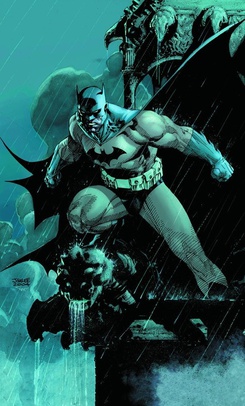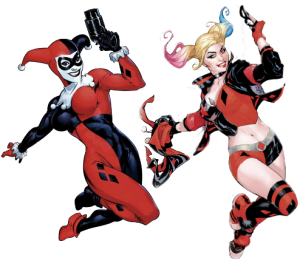
Batman is a superhero appearing in American comic books published by DC Comics. The character was created by artist Bob Kane and writer Bill Finger, and debuted in the 27th issue of the comic book Detective Comics on March 30, 1939. In the DC Universe continuity, Batman is the alias of Bruce Wayne, a wealthy American playboy, philanthropist, and industrialist who resides in Gotham City. Batman's origin story features him swearing vengeance against criminals after witnessing the murder of his parents Thomas and Martha as a child, a vendetta tempered with the ideal of justice. He trains himself physically and intellectually, crafts a bat-inspired persona, and monitors the Gotham streets at night. Kane, Finger, and other creators accompanied Batman with supporting characters, including his sidekicks Robin and Batgirl; allies Alfred Pennyworth, James Gordon, and Catwoman; and foes such as the Penguin, the Riddler, Two-Face, and his archenemy, the Joker.

Harley Quinn is a character appearing in American comic books published by DC Comics. She was created by Paul Dini and Bruce Timm for Batman: The Animated Series as a henchwoman for the Joker, and debuted in its 22nd episode, "Joker's Favor", on September 11, 1992. While intended to appear in one episode, Quinn became a recurring character within the DC Animated Universe (DCAU) as the Joker's sidekick and love interest, and was adapted into DC Comics' canon seven years later, beginning with the one-shot Batman: Harley Quinn #1. Quinn's origin story features her as a former psychologist at Gotham City's Arkham Asylum who was manipulated by and fell in love with the Joker, her patient, eventually becoming his accomplice and lover. The character's alias is a play on the stock character Harlequin from the 16th-century Italian theater commedia dell'arte.

Batman Beyond is an American superhero animated television series based on the DC Comics superhero Batman. Created and developed by Paul Dini, Bruce Timm, and Alan Burnett and produced by Warner Bros. Animation, the series began airing on January 10, 1999 on Kids' WB, and ended on December 18, 2001. In the United Kingdom, it began airing on September 4, 2000. After 52 episodes spanning three seasons and one direct-to-video feature film, the series was brought to an end in favor of the Justice League animated series. Depicting a teenaged Batman in a futuristic Gotham City under the tutelage of an elderly Bruce Wayne, Batman Beyond is the third series of the DC Animated Universe, and serves as the sequel to both Batman: The Animated Series and The New Batman Adventures.

Alfred Thaddeus Crane Pennyworth, originally Alfred Beagle and commonly known simply as Alfred, is a fictional character appearing in American comic books published by DC Comics, most commonly in association with the superhero Batman.

James W. "Jim" Gordon is a fictional character appearing in American comic books published by DC Comics, most commonly in association with the superhero Batman. Created by Bill Finger and Bob Kane as an ally of Batman, the character debuted in the first panel of Detective Comics #27, Batman's first appearance, making him the first Batman supporting character ever to be introduced, eventually succeeding him as Batman from 2015 to 2016.

Batgirl is the name of several fictional superheroines appearing in American comic books published by DC Comics, depicted as female counterparts and allies to the superhero Batman. The character Betty Kane was introduced into publication in 1961 by Bill Finger and Sheldon Moldoff as Bat-Girl, and was replaced in 1967 by Barbara Gordon, who became the iconic Batgirl. The character debuted in Detective Comics #359 by writer Gardner Fox and artist Carmine Infantino, introduced as the niece/adoptive daughter of police commissioner James Gordon.

Lucius Fox is a character appearing in American comic books published by DC Comics, commonly in association with the superhero Bruce Wayne / Batman. He is Wayne's business manager at Wayne Enterprises who runs the business interests that supply his equipment needs as well as financing his operations, and is the father of Luke Fox / Batwing, Tiffany Fox / Batgirl, and Jace Fox / Batman.

Batman, also known as Batman Beyond after his animated television series to distinguish him from Bruce Wayne, is a superhero appearing in media published by DC Entertainment. The character was created by Bruce Timm and Paul Dini and first appeared in the pilot episode of Batman Beyond (1999–2001) set in the DC Animated Universe, voiced by Will Friedle.

The New Batman Adventures is an American animated superhero television series based on the DC Comics superhero Batman, which aired on Kids' WB from September 13, 1997 to January 16, 1999. Produced by Warner Bros. Animation, it is a continuation of Batman: The Animated Series (1992–1995), serving as the fourth and fifth seasons of the show, and the third series in the DC Animated Universe. It was followed by Batman Beyond (1999–2001). The series was revamped from BTAS, replacing its art style with streamlined designs for more consistent animation, and to maintain similarity with the simultaneously running Superman: The Animated Series (1996–2000), with episodes airing on Kids' WB under the title The New Batman/Superman Adventures.

The DC Comics character Batman has been adapted into various media including film, radio, television, and video games, as well as numerous merchandising items. The Batman franchise has become one of the highest-grossing media franchises of all time.

Martha Wayne is a fictional character appearing in American comic books published by DC Comics, commonly in association with the superhero Batman. She is the mother of Bruce Wayne (Batman), and wife of Dr. Thomas Wayne as well as the paternal grandmother of Damian Wayne, the fifth Robin. After she and her husband are murdered in a street robbery, her son becomes inspired to fight crime as the vigilante known as Batman.

In addition to DC Comics books, the superhero Robin also appears in other media, such as films, television and radio. Dick Grayson, Jason Todd, Tim Drake, Stephanie Brown, and Damian Wayne are examples of the characters who use the name Robin.

The Super Powers Team: Galactic Guardians is an American animated television series about a team of superheroes that ran in 1985. It was produced by Hanna-Barbera Productions and is based on the Justice League and associated comic book characters published by DC Comics.
Originally created in 1967, the fictional comic book character Barbara Gordon has been adapted into various other forms of media. The character has appeared in both live action and animated television series and films, as well as in video games in her alter-egos as both Batgirl and Oracle.

Batman: The Brave and the Bold is an American animated television series based in part on the DC Comics series The Brave and the Bold which features two or more superheroes coming together to solve a crime or foil a super villain. As the title suggests, the series focuses on Batman's regular "team-ups" with various heroes similar to the most well-known version of the original comic book series. This version has a much lighter and simpler, often comic feel, targeting younger viewers more than the character's other series. The series premiered on November 14, 2008, on Cartoon Network in the United States, and ended on November 18, 2011. It also aired in Canada on Teletoon.
Movie Masters is an action figure toyline from Mattel based on popular movie franchises, most notably DC Comics. The line has featured characters from the films Superman, Avatar, The Dark Knight trilogy, Green Lantern, and Man of Steel. Figures in the line are sculpted by Four Horsemen Studios, who also sculpted figures for Mattel's DC Superheroes and DC Universe Classics lines.

Batman Beyond is a comic book series featuring the fictional character Terry McGinnis as Batman and based on the animated television series of the same name. It has appeared in various DC Comics publications, including a six-issue miniseries from 1999, a 24-issue series running from 1999 to 2001, the "Hush" arc by DC Comics in 2010, and an eight-issue miniseries in 2011. A short-running series titled Batman Beyond Unlimited was later released, followed by Batman Beyond 2.0 in 2013.

Batman vs. Teenage Mutant Ninja Turtles is an American animated superhero film directed by Jake Castorena and written by Marly Halpern-Graser. Based on the comic book miniseries Batman/Teenage Mutant Ninja Turtles by James Tynion IV and Freddie Williams II, the story focuses on Batman, Robin, and Batgirl teaming up with the Teenage Mutant Ninja Turtles in order to save Gotham City from chaos at the hands of both Shredder and Ra's al Ghul. Produced by Warner Bros. Animation in association with DC Entertainment and Nickelodeon, the film features the voices of Troy Baker, Eric Bauza, Darren Criss, Kyle Mooney, and Baron Vaughn.
















